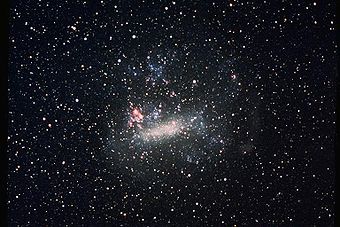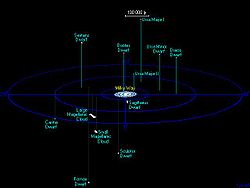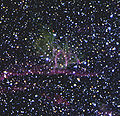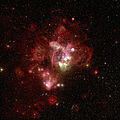- Large Magellanic Cloud
-
Large Magellanic Cloud 
The Large Magellanic CloudObservation data (J2000 epoch) Constellation Dorado/Mensa Right ascension 05h 23m 34.5s[1] Declination -69° 45′ 22″[1] Distance 157 kly (48.5 kpc)[2][3][4] Type SB(s)m[1] Apparent dimensions (V) 10.75° × 9.17°[1] Apparent magnitude (V) 0.9[1] Other designations LMC, ESO 56- G 115, PGC 17223,[1] Nubecula Major[5] See also: Galaxy, List of galaxies The Large Magellanic Cloud (LMC) is a nearby irregular galaxy, and is a satellite of the Milky Way.[6] At a distance of slightly less than 50 kiloparsecs (≈160,000 light-years),[2][3][4] the LMC is the third closest galaxy to the Milky Way, with the Sagittarius Dwarf Spheroidal (~ 16 kiloparsecs) and Canis Major Dwarf Galaxy (~ 12.9 kiloparsecs) lying closer to the center of the Milky Way. It has a mass equivalent to approximately 10 billion times the mass of our Sun (1010 solar masses), making it roughly 1/100 as massive as the Milky Way, and a diameter of about 14,000 light-years.[7] The LMC is the fourth largest galaxy in the Local Group, the first, second and third largest places being taken by Andromeda Galaxy (M31), our own Milky Way Galaxy, and the Triangulum Galaxy (M33), respectively.
While the LMC is often considered an irregular type galaxy (the NASA Extragalactic Database lists the Hubble sequence type as Irr/SB(s)m), the LMC contains a very prominent bar in its center, suggesting that it may have previously been a barred spiral galaxy. The LMC's irregular appearance is possibly the result of tidal interactions with both the Milky Way, and the Small Magellanic Cloud (SMC).
It is visible as a faint "cloud" in the night sky of the southern hemisphere straddling the border between the constellations of Dorado and Mensa.
Contents
History
The very first recorded mention of the Large Magellanic Cloud was by the Persian astronomer, Al-Rahman Al Sufi (later known in Europe as "Azophi"), in his Book of Fixed Stars around 964 AD.[8][9]
The next recorded observation was in 1503–4 by Amerigo Vespucci in a letter about his third voyage. In this letter he mentions "three Canopes, two bright and one obscure"; "bright" refers to the two Magellanic Clouds, and "obscure" refers to the Coalsack.[10]
Ferdinand Magellan sighted the LMC on his voyage in 1519, and his writings brought the LMC into common Western knowledge. The galaxy now bears his name.[9]
Geometry
The Large Magellanic Cloud has a prominent central bar and a spiral arm.[11] The central bar seems to be warped so that the east and west ends are nearer the Milky Way than the middle.[12]
The LMC was long considered to be a planar galaxy that could be assumed to lie at a single distance from us. However, in 1986, Caldwell and Coulson[13] found that field Cepheid variables in the northeast portion of the LMC lie closer to the Milky Way than Cepheids in the southwest portion. More recently, this inclined geometry for field stars in the LMC has been confirmed via observations of Cepheids,[14] core helium-burning red clump stars[15] and the tip of the red giant branch.[16] All three of these papers find an inclination of ~35°, where a face-on galaxy has an inclination of 0°. Further work on the structure of the LMC using the kinematics of carbon stars showed that the LMC's disk is both thick[16] and flared.[17] Regarding the distribution of star clusters in the LMC, Schommer et al.[18] measured velocities for ~80 clusters and found that the LMC's cluster system has kinematics consistent with the clusters moving in a disk-like distribution. These results were confirmed by Grocholski et al.,[19] who calculated distances to a number of clusters and showed that the LMC's cluster system is in fact distributed in the same plane as the field stars.
Distance
Determining a precise distance to the LMC, as with any other galaxy, was challenging due to the use of standard candles for calculating distances, with the primary problem being that many of the standard candles are not as 'standard' as one would like; in many cases, the age and/or metallicity of the standard candle plays a role in determining the intrinsic luminosity of the object. The distance to the LMC has been calculated using a variety of standard candles, with Cepheid variables being one of the most popular. Cepheids have been shown to have a relationship between their absolute luminosity and the period over which their brightness varies. However, Cepheids appear to suffer from a metallicity effect, where Cepheids of different metallicities have different period-luminosity relations. Unfortunately, the Cepheids in the Milky Way typically used to calibrate the period-luminosity relation are more metal rich than those found in the LMC.[20]
In the era of 8-meter-class telescopes, eclipsing binaries have been found throughout the Local Group. Parameters of these systems can be measured without mass or compositional assumptions. The light echoes of supernova 1987A are also geometric measurements, without any stellar models or assumptions.
Recently, the Cepheid absolute luminosity has been re-calibrated using Cepheid variables in the galaxy NGC 4258 that cover a range of metallicities.[2] Using this improved calibration, they find an absolute distance modulus of (m − M)0 = 18.41, or 48 kpc (~157,000 light years). This distance, which is slightly shorter than the typically assumed distance of 50 kpc, has been confirmed by other authors.[3][4]
By cross-correlating different measurement methods, one can bound the distance; the residual errors are now less than the estimated size parameters of the LMC. Further work involves measuring the position of a target star or star system within the galaxy (i.e., toward or away from the observer).
Features
Like many irregular galaxies, the LMC is rich in gas and dust, and it is currently undergoing vigorous star formation activity.[21] It is home to the Tarantula Nebula, the most active star-forming region in the Local Group.
The LMC is full of a wide range of galactic objects and phenomena that make it aptly known as an "astronomical treasure-house, a great celestial laboratory for the study of the growth and evolution of the stars," as described by Robert Burnham, Jr.[22] Surveys of the galaxy have found roughly 60 globular clusters, 400 planetary nebulae, and 700 open clusters, along with hundreds of thousands of giant and supergiant stars.[23] Supernova 1987a—the nearest supernova in recent years—was also located in the Large Magellanic Cloud. The Lionel-Murphy SNR is nitrogen-abundant supernova remnant (SNR) N86 in the Large Magellanic Cloud named by astronomers at the Australian National University's Mount Stromlo Observatory in acknowledgement of Australian High Court Justice Lionel Murphy's interest in science and because of SNR N86's perceived resemblance to his large nose.[24]
There is a bridge of gas connecting the Small Magellanic Cloud (SMC) with the LMC, which is evidence of tidal interaction between both galaxies.[25] The Magellanic Clouds have a common envelope of neutral hydrogen indicating they have been gravitationally bound for a long time. This bridge of gas is a star forming site.[26]
X-ray sources
No X-rays above background were observed from the Magellanic Clouds during the September 20, 1966, Nike Tomahawk flight.[27] A second Nike Tomahawk rocket was launched from Johnston Atoll on September 22, 1966, at 17:13 UTC and reached an apogee of 160 km, with spin-stabilization at 5.6 rps.[28] The LMC was not detected in the X-ray range 8-80 keV.[28]
Another Nike Tomahawk was launched from Johnston Atoll at 11:32 UTC on October 29, 1968, to scan the LMC for X-rays.[29] The first discrete X-ray source in Dorado was at RA 05h 20m Dec -69°,[29][30] and it was the Large Magellanic Cloud.[31] This X-ray source extended over about 12° and is consistent with the Cloud.[29] Its emission rate between 1.5-10.5 keV for a distance of 50 kpc is 4 x 1038 ergs/s.[29] An X-ray astronomy instrument was carried aboard a Thor missile launched from Johnston Atoll on September 24, 1970, at 12:54 UTC and altitudes above 300 km, to search for the Small Magellanic Cloud and to extend previous observations of the LMC.[32] The source in the LMC appeared extended and contained the star ε Dor.[32] The X-ray luminosity (Lx) over the range 1.5–12 keV was 6 × 1031 W (6 × 1038 erg/s).[32]
The Large Magellanic Cloud (LMC) is in the constellations Mensa and Dorado. LMC X-1 (the first X-ray source in the LMC) is at RA 05h 40m 05s Dec -69° 45′ 51″, and is a high mass X-ray binary source (HMXB).[33][34] Of the first five luminous LMC X-ray binaries: LMC X-1, X-2, X-3, X-4, and A 0538-66 (detected by Ariel 5 at A 0538-66); LMC X-2 is the only one that is a bright low-mass X-ray binary system (LMXB) in the LMC.[35]
 This is a composite image of X-ray (red and green)/optical (purple) for DEM L316. Two supernova remnants (SNRs) are imaged by Chandra. Image is 5.7 arcmin across. RA 05h 47m 15.00s Dec -69º 42' 25.00" in Dorado. Observation date: 27 July 2002. Color code: X-ray (Red 0.8-1.5 keV, Green 1.5-8 keV, Blue 0.3-8 keV); Optical (Purple). Instrument: ACIS. Aka: WCD97 Shell A, WCD97 Shell B. Credit: X-ray: NASA/CXC/U.Illinois/R.Williams & Y.-H.Chu; Optical: NOAO/CTIO/U.Illinois/R.Williams & MCELS coll.
This is a composite image of X-ray (red and green)/optical (purple) for DEM L316. Two supernova remnants (SNRs) are imaged by Chandra. Image is 5.7 arcmin across. RA 05h 47m 15.00s Dec -69º 42' 25.00" in Dorado. Observation date: 27 July 2002. Color code: X-ray (Red 0.8-1.5 keV, Green 1.5-8 keV, Blue 0.3-8 keV); Optical (Purple). Instrument: ACIS. Aka: WCD97 Shell A, WCD97 Shell B. Credit: X-ray: NASA/CXC/U.Illinois/R.Williams & Y.-H.Chu; Optical: NOAO/CTIO/U.Illinois/R.Williams & MCELS coll.
DEM L316 in the Large Magellanic Cloud consists of two supernove remnants.[36] Chandra X-ray spectra show that the hot gas shell on the upper left contains a high abundance of iron.[36] This implies that the upper left SNR is the product of a Type Ia supernova.[36] The much lower iron abundance in the lower SNR indicates a Type II supernova.[36]
A 16 ms X-ray pulsar is associated with SNR 0538-69.1.[37] SNR 0540-697 was resolved using ROSAT.[38]
View from the LMC
From a viewpoint in the LMC, the Milky Way would be a spectacular sight. The galaxy's total apparent magnitude would be −2.0—over 14 times brighter than the LMC appears to us on Earth—and it would span about 36° across the sky, which is the width of over 70 full moons. Furthermore, because of the LMC's high galactic latitude, an observer there would get an oblique view of the entire galaxy, free from the interference of interstellar dust which makes studying in the Milky Way's plane difficult from Earth.[39] The Small Magellanic Cloud would be about magnitude 0.6, substantially brighter than the LMC appears to us.
Gallery
See also
Notes
- ^ a b c d e f "NASA/IPAC Extragalactic Database". Results for Large Magellanic Cloud. http://nedwww.ipac.caltech.edu/. Retrieved 2006-10-29.
- ^ a b c Macri, L. M.; et al. (2006). "A New Cepheid Distance to the Maser-Host Galaxy NGC 4258 and Its Implications for the Hubble Constant". The Astrophysical Journal 652 (2): 1133–1149. arXiv:astro-ph/0608211. Bibcode 2006ApJ...652.1133M. doi:10.1086/508530.
- ^ a b c Freedman, Wendy L.; Madore, Barry F. "The Hubble Constant", Annual Review of Astronomy and Astrophysics, 2010
- ^ a b c Majaess, Daniel J.; Turner, David G.; Lane, David J.; Henden, Arne; Krajci, Tom "Anchoring the Universal Distance Scale via a Wesenheit Template", JAAVSO, 2010
- ^ Astronomical Society of the Pacific Leaflets, "The Magellanic Clouds", Buscombe, William, v.7, p.9, 1954, Bibcode: 1954ASPL....7....9B
- ^ http://adsabs.harvard.edu/abs/2009MNRAS.392L..21S
- ^ "Magellanic Cloud." Encyclopædia Britannica. 2009. Encyclopædia Britannica Online. 30 Aug. 2009.
- ^ "Observatoire de Paris (Abd-al-Rahman Al Sufi)". http://messier.obspm.fr/xtra/Bios/alsufi.html. Retrieved 2007-04-19.
- ^ a b "Observatoire de Paris (LMC)". http://messier.obspm.fr/xtra/ngc/lmc.html. Retrieved 2007-04-19.
- ^ "Observatoire de Paris (Amerigo Vespucci)". http://messier.obspm.fr/xtra/Bios/vespucci.html. Retrieved 2007-04-19.
- ^ Nicolson, Iain (1999). Unfolding our Universe. USA. pp. 213–214. ISBN 0-521-59270-4. http://books.google.com/?id=5iacbufd4kEC&printsec=frontcover&q=.
- ^ Subramaniam, Annapurni (2003-11-03). "Large Magellanic Cloud Bar: Evidence of a Warped Bar". The Astrophysical Journal (USA) 598: L19–L22. Bibcode 2003ApJ...598L..19S. doi:10.1086/380556. http://www.iop.org/EJ/article/1538-4357/598/1/L19/17609.web.pdf?request-id=97601007-bd6e-4a75-a90b-679dad73bf04. Retrieved 2009-10-31.
- ^ Caldwell, J. A. R.; Coulson, I. M. (1986). "The geometry and distance of the Magellanic Clouds from Cepheid variables". Royal Astronomical Society, Monthly Notices 218: 223–246. Bibcode 1986MNRAS.218..223C.
- ^ Nikolaev, S.; et al. (2004). "Geometry of the Large Magellanic Cloud Disk: Results from MACHO and the Two Micron All Sky Survey". The Astrophysical Journal 601 (1): 260–276. Bibcode 2004ApJ...601..260N. doi:10.1086/380439.
- ^ Olsen, K. A. G.; Salyk, C. (2002). "A Warp in the Large Magellanic Cloud Disk?". The Astronomical Journal 124 (4): 2045–2053. Bibcode 2002AJ....124.2045O. doi:10.1086/342739. http://www.iop.org/EJ/article/1538-3881/124/4/2045/202206.html.
- ^ a b van der Marel, R. P.; Cioni, M.-R. L. (2001). "Magellanic Cloud Structure from Near-Infrared Surveys. I. The Viewing Angles of the Large Magellanic Cloud". The Astronomical Journal 122 (4): 1807–1826. arXiv:astro-ph/0105339. Bibcode 2001AJ....122.1807V. doi:10.1086/323099. http://www.iop.org/EJ/article/1538-3881/122/4/1807/201194.html.
- ^ Alves, D. R.; Nelson, C. A. (2000). "The Rotation Curve of the Large Magellanic Cloud and the Implications for Microlensing". The Astrophysical Journal 542 (2): 789–803. arXiv:astro-ph/0006018. Bibcode 2000ApJ...542..789A. doi:10.1086/317023.
- ^ Schommer, R. A.; et al. (1992). "Spectroscopy of giants in LMC clusters. II - Kinematics of the cluster sample". Astronomical Journal 103: 447–459. Bibcode 1992AJ....103..447S. doi:10.1086/116074.
- ^ Grocholski, A. J.; et al. (2007). "Distances to Populous Clusters in the Large Magellanic Cloud via the K-band Luminosity of the Red Clump". The Astronomical Journal 134 (2): 680–693. Bibcode 2007AJ....134..680G. doi:10.1086/519735.
- ^ Mottini, M.; Romaniello, M.; Primas, F.; Bono, G.; Groenewegen, M. A. T.; François, P. "The chemical composition of Cepheids in the Milky Way and the Magellanic Clouds", MmSAI, 2006
- ^ Arny, Thomas T. (2000). Explorations: An Introduction to Astronomy (2nd ed.). Boston: McGraw-Hill. p. 479. ISBN 0072282495.
- ^ Burnham, Robert, Jr. (1978). Burnham's Celestial Handbook: Volume Two. New York: Dover. p. 837. ISBN 048623567X.
- ^ Burnham (1978), 840–848.
- ^ Dopita MA, Mathewson DS, Ford VL. Optical emission from shock waves. III. Abundances in supernova remnants. The Astrophysical Journal. 1977; 214: 179-188 plate 4
- ^ Mathewson DS, Ford VL (1984). IAUS 108: 125.
- ^ Heydari-Malayeri M, Meynadier F, Charmandaris V, Deharveng L, Le Bertre T, Rosa MR, Schaerer D (2003). "The stellar environment of SMC N81". Astron Astrophys. 411 (3): 427. arXiv:astro-ph/0309126. Bibcode 2003A&A...411..427H. doi:10.1051/0004-6361:20031360.
- ^ Chodil G, Mark H, Rodrigues R, Seward FD, Swift CD (Oct 1967). "X-Ray Intensities and Spectra from Several Cosmic Sources". Ap J. 150 (10): 57–65. Bibcode 1967ApJ...150...57C. doi:10.1086/149312.
- ^ a b Seward FD, Toor A (Nov 1967). "Search for 8-80 KEV X-Rays from the Large Magellanic Cloud and the Crab Nebula". Ap J. 150 (11): 405–12. Bibcode 1967ApJ...150..405S. doi:10.1086/149343.
- ^ a b c d Mark H, Price R, Rodrigues R, Seward FD, Swift CD (Mar 1969). "Detection of X-rays from the large magellanic cloud". Ap J Lett. 155 (3): L143–4. Bibcode 1969ApJ...155L.143M. doi:10.1086/180322.
- ^ Lewin WHG, Clark GW, Smith WB (1968). Nature. 220 (5164): 249. Bibcode 1968Natur.220..249L. doi:10.1038/220249b0.
- ^ Dolan JF (Apr 1970). "A Catalogue of Discrete Celestial X-Ray Sources". Astron J. 75 (4): 223–30. Bibcode 1970AJ.....75..223D. doi:10.1086/110966.
- ^ a b c Price RE, Groves DJ, Rodrigues RM, Seward FD, Swift CD, Toor A (Aug 1971). "X-Rays from the Magellanic Clouds". Ap J. 168 (8): L7–9. Bibcode 1971ApJ...168L...7P. doi:10.1086/180773.
- ^ Rapley, Tuohy (1974).
- ^ Johnston et al. (1978).
- ^ Bonnet-Bidaud JM, Motch C, Beuermann K, Pakull M, Parmar AN, van der Klis M (Apr 1989). "LMC X-2: an extragalactic bulge-type source". Astron Astrophys. 213 (1-2): 97–106. Bibcode 1989A&A...213...97B.
- ^ a b c d Williams RM, Chu YH (Dec 2005). "Supernova Remnants in the Magellanic Clouds. VI. The DEM L316 Supernova Remnants". Ap J. 635 (2): 1077–86. arXiv:astro-ph/0509696. Bibcode 2005ApJ...635.1077W. doi:10.1086/497681. http://iopscience.iop.org/0004-637X/635/2/1077/pdf/0004-637X_635_2_1077.pdf.
- ^ Marshall et al. (1998).
- ^ Chu et al (1997).
- ^ Some of the figures in the "View" section were extrapolated from data in the Appendix of Chaisson and McMillan's Astronomy Today (Englewood Cliffs: Prentice-Hall, Inc., 1993).
External links
The Milky Way Location Milky Way subgroup → Local Group → Virgo Supercluster → Pisces-Cetus Supercluster Complex → Observable universe → UniverseGalactic core Spiral arms Satellite galaxies Sagittarius Stream · Boötes II · Coma Berenices · Messier 54 · Palomar 12 · Segue 1 · Segue 2 · Terzan 7Boötes I · Boötes III · Canes Venatici I · Canes Venatici II · Canis Major · Carina · Draco · Fornax · Hercules · Leo I · Leo II · Leo IV · Leo V · Phoenix · Pisces I · Pisces II · Sculptor · Sextans · Ursa Major I · Ursa Major II · Ursa MinorOtherCategories:- Dwarf barred irregular galaxies
- Mensa constellation
- Dorado constellation
- Large Magellanic Cloud
- Magellanic Clouds
- Milky Way Subgroup
- PGC objects
Wikimedia Foundation. 2010.








